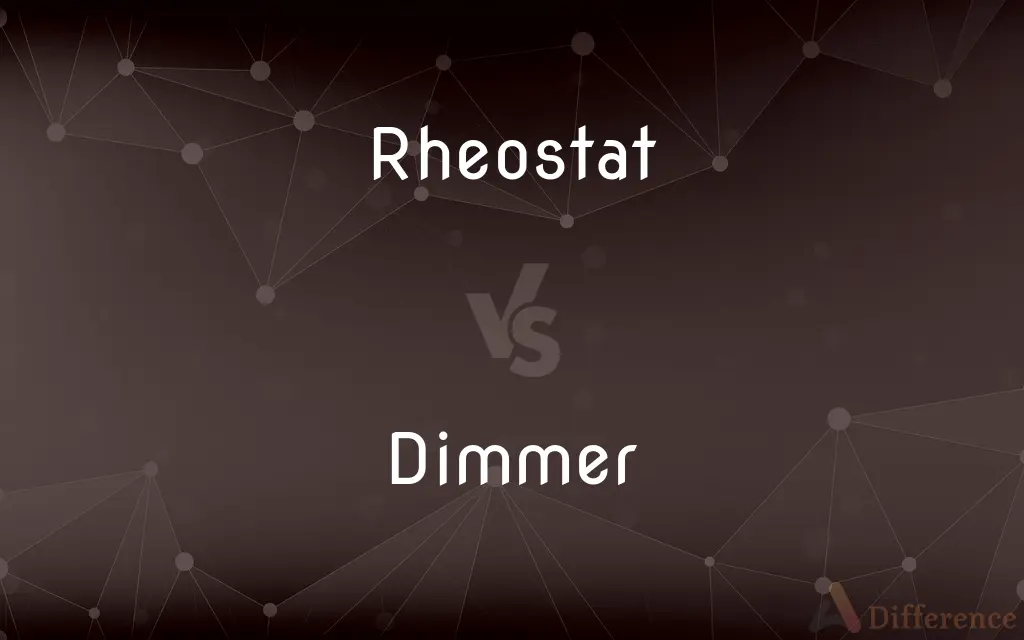Rheostat vs. Dimmer — What's the Difference?
By Tayyaba Rehman — Updated on September 22, 2023
A rheostat is a device that adjusts electrical resistance, while a dimmer regulates the brightness of lights. Both control power, but in different contexts.

Difference Between Rheostat and Dimmer
Table of Contents
ADVERTISEMENT
Key Differences
Rheostat and dimmer are both devices that regulate the amount of power flowing through a circuit, but they operate under different principles and for distinct purposes. A rheostat specifically varies electrical resistance to control current. When one mentions a rheostat, it often conjures thoughts of older technologies or specific laboratory applications.
On the other hand, a dimmer is commonly associated with household lighting systems. While a rheostat works by adjusting resistance, a dimmer modifies voltage to control the brightness level of lights. The household familiarity of dimmers means that for many, the term is synonymous with those switches that modulate light intensity in living rooms or dining areas.
While both the rheostat and dimmer serve to control power, the rheostat has a broader application, found in various electrical and electronic devices. In contrast, a dimmer's primary purpose is for light modulation, ensuring that rooms can have ambient lighting as desired.
The distinction between a rheostat and a dimmer also extends to their efficiency. Modern dimmers, especially those designed for LED lighting, are crafted to be energy efficient. In contrast, rheostats, due to their resistive nature, can dissipate a significant amount of power as heat.
Comparison Chart
Primary Function
Adjusts electrical resistance
Regulates brightness of lights
ADVERTISEMENT
Common Usage
Various electrical and electronic devices
Household lighting systems
Operating Method
By varying resistance
By modifying voltage
Efficiency
Can dissipate power as heat
Designed to be energy efficient, especially with LED lighting
Associations
Older technologies, laboratory applications
Ambient room lighting
Compare with Definitions
Rheostat
A device that varies electrical resistance.
He adjusted the rheostat to control the current.
Dimmer
Provides energy-efficient light modulation.
With the dimmer, she saved energy while maintaining desired light levels.
Rheostat
Can regulate current flow.
By tweaking the rheostat, he managed the flow of current.
Dimmer
A device to control light brightness.
She used the dimmer to set the mood in the dining room.
Rheostat
Often associated with older technologies.
Vintage radios often utilized rheostats for volume control.
Dimmer
Works by adjusting voltage.
The dimmer effectively reduced the voltage to the light bulb.
Rheostat
Used in electrical and electronic devices.
The lab equipment had a built-in rheostat for precise control.
Dimmer
Dimmers are devices connected to a light fixture and used to lower the brightness of light. By changing the voltage waveform applied to the lamp, it is possible to lower the intensity of the light output.
Rheostat
Operates by changing resistance.
The rheostat's resistance alteration affected the device's performance.
Dimmer
A device for varying the brightness of an electric light.
Rheostat
An electrical instrument used to control a current by varying the resistance.
Dimmer
A headlight with a low beam.
Rheostat
A potentiometer used as a variable resistor.
Dimmer
A rheostat or other device used to vary the intensity of an electric light.
Rheostat
An electrical resistor, with two terminals, whose resistance is continuously variable by moving a knob or slider.
Dimmer
A parking light on a motor vehicle.
Rheostat
A contrivance for adjusting or regulating the strength of electrical currents, operating usually by the intercalation of resistance which can be varied at will.
Dimmer
A low beam.
Rheostat
Resistor for regulating current
Dimmer
A rheostat that is used to vary the intensity of a domestic electric light
Dimmer
A switch used to select between the low and high headlamp beam on a road vehicle. (usually as "dimmer switch", primarily in North America; elsewhere "dipswitch" or "dipper switch")
Dimmer
A rheostat that varies the current through an electric light in order to control the level of illumination
Dimmer
Common in household lighting.
Installing a dimmer in the living room enhanced the ambiance.
Dimmer
Compatible with various light types.
The LED-compatible dimmer provided energy-efficient brightness control.
Common Curiosities
Is a dimmer energy efficient?
Modern dimmers, especially those for LEDs, are designed to be energy efficient.
How does a dimmer function?
A dimmer regulates the brightness of lights by adjusting the voltage.
What does a rheostat control?
A rheostat controls electrical resistance in a circuit.
Are dimmers only used for lighting?
Primarily, dimmers are used for lighting, but some specialized applications might exist.
Why might one use a rheostat?
Rheostats are used for varying resistance and controlling current in certain devices.
Can I use a rheostat for my home lighting?
It's more practical and efficient to use dimmers for home lighting.
Can a rheostat control light brightness like a dimmer?
While a rheostat can control current, it's not as efficient or effective for light modulation as a dimmer.
What's the advantage of a dimmer in household use?
Dimmers provide variable light control, energy savings, and can extend bulb life.
Are all dimmers compatible with LEDs?
Not all. Ensure the dimmer specifies LED compatibility.
Do rheostats waste energy?
Due to their resistive nature, rheostats can dissipate some power as heat.
Can I replace a regular light switch with a dimmer?
Yes, but ensure the dimmer is compatible with the light type and follow installation guidelines.
What's the main difference between a rheostat and a dimmer?
A rheostat adjusts electrical resistance, while a dimmer controls light brightness.
How do I know if my device uses a rheostat?
A device might label or specify its use of a rheostat, or you might notice resistive adjustments in its operation.
Are rheostats still widely used?
While not as prevalent as before, rheostats still find applications in specific devices and scenarios.
Do dimmers work with all light bulb types?
Most dimmers work with incandescent and halogen bulbs, but for CFLs and LEDs, a compatible dimmer is needed.
Share Your Discovery

Previous Comparison
Homie vs. Homey
Next Comparison
Godsent vs. GodsendAuthor Spotlight
Written by
Tayyaba RehmanTayyaba Rehman is a distinguished writer, currently serving as a primary contributor to askdifference.com. As a researcher in semantics and etymology, Tayyaba's passion for the complexity of languages and their distinctions has found a perfect home on the platform. Tayyaba delves into the intricacies of language, distinguishing between commonly confused words and phrases, thereby providing clarity for readers worldwide.















































